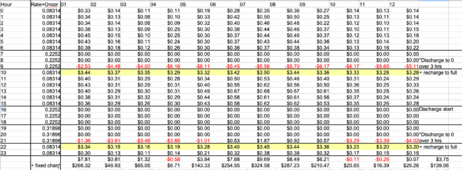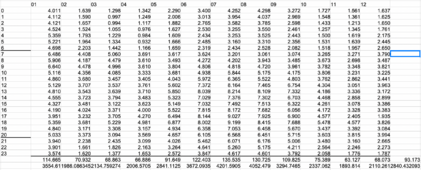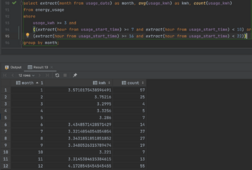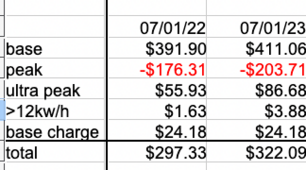Ok, if let's say it costs you $16000 after tax credit, to break even in 7 years you'll need to save about $6 per day. They could be doable if everything goes right.My highest all time peaks are in winter at 29kwh during the freezes. Hence why I chose a hybrid inverter with 200 amp passthrough.
My average peak usage for a month is 8.17kwh in July around 4pm.
Average usage per month is 93.5kwh/day and $370/mo @ $0.13/kwh.
My house runs on electric except for the cooktop and fireplace that run on propane.
You are using an out of date browser. It may not display this or other websites correctly.
You should upgrade or use an alternative browser.
You should upgrade or use an alternative browser.
Need electrician help near DFW, TX --> Found
- Thread starter blueforce
- Start date
I'm assuming a total cost just under $14k. Always gotta ask for that veteran discountOk, if let's say it costs you $16000 after tax credit, to break even in 7 years you'll need to save about $6 per day. They could be doable if everything goes right.
Currently I'm paying over $12/day but with net metering and monthly credit rollover I should be down to about $1.62/day. <-Assuming all goes right. This would lead to a <4 year payback.
$1.62/ day? You'll have to show me that math.I'm assuming a total cost just under $14k. Always gotta ask for that veteran discount
Currently I'm paying over $12/day but with net metering and monthly credit rollover I should be down to about $1.62/day. <-Assuming all goes right. This would lead to a <4 year payback.
Daily Export kWh and price,
Daily Import kWh and price
Thanks
Wow, in my evolving calculations I forgot to include a full battery recharge and was only accounting for recharging based on usage. This is why we do code reviews in software engineering. Changes the payback to under 5 years and the daily charge to $3.75.$1.62/ day? You'll have to show me that math.
Daily Export kWh and price,
Daily Import kWh and price
The negative numbers don't include the Oncor delivery charge of .0454 and are only the credit rate.
Attachments
Ok couple of thingsWow, in my evolving calculations I forgot to include a full battery recharge and was only accounting for recharging based on usage. This is why we do code reviews in software engineering. Changes the payback to under 5 years and the daily charge to $3.75.
The negative numbers don't include the Oncor delivery charge of .0454 and are only the credit rate.
First, what is using so much energy in your house? I understand it's all electric but it was built in 2022 so it should be efficient. Your consumption seems very high.
In comparison my house is all electric, family of four and I'm averaging 1340kwh a month.
Do you have something very energy intensive? Mining Bitcoin? Charging evs?
Secondly, you don't show any draw at all from the grid between 4pm and 10pm. With the amount of energy you use that seems almost impossible. In the heat of summer, with ac running hard, water heater and other daily activities you are almost certain to exceed 12kw at times meaning you will pull some from the grid during those times.
Have you done a deep dive into your 15 minute data to see how often you exceeded 12kw during peak times?
My house is 3300 sqft and besides your normal household things I have:First, what is using so much energy in your house? I understand it's all electric but it was built in 2022 so it should be efficient. Your consumption seems very high.
In comparison my house is all electric, family of four and I'm averaging 1340kwh a month.
Do you have something very energy intensive? Mining Bitcoin? Charging evs?
- 2x chest freezers
- 2x Heat pumps (4 ton downstairs and 2.5 ton upstairs)
- 2x water heaters that, combined, draw 10kw (These are connected in parallel. I need to change to series and use one as an in-line spare)
- Pool with 2.75 hp main pump and 1 hp accessory pump
I work from home upstairs and my wife is a stay at home mom. All of my children are also still in the nap stage, 2.5yo and below, and they nap upstairs. What this means is our HVAC is almost always working. We also like the temperature low which doesn't help energy use.
Edit: no EVs and no bitcoin
4p -10p I should be running off batteries and selling excess which would require monthly sell to grid adjustments in the inverter. You can see those credits on line 21. You should also see that by 9pm Jun-Sep I'll run out of battery and have to rely on grid for that last hour, hence the high monthly charge during those months on the last line. I've attached my avg kwh usage by hour and month. Of course there will be times when I exceed 12kw, mostly during winter, but the average will be less than that.Secondly, you don't show any draw at all from the grid between 4pm and 10pm. With the amount of energy you use that seems almost impossible. In the heat of summer, with ac running hard, water heater and other daily activities you are almost certain to exceed 12kw at times meaning you will pull some from the grid during those times.
Looking at the attached sql query you can see the amount of times I've exceeded 12kw (3kw in 15 minutes).Have you done a deep dive into your 15 minute data to see how often you exceeded 12kw during peak times?
Edit: that's 2 years of data
Attachments
Last edited:
My house is 3300 sqft and besides your normal household things I have:
- 2x chest freezers
- 2x Heat pumps (4 ton downstairs and 2.5 ton upstairs)
- 2x water heaters that, combined, draw 10kw (These are connected in parallel. I need to change to series and use one as an in-line spare)
The good news with having two water heaters, you can set the temp up and use a timer to set them to never come in between 4 and 10. That reduces need demand by 10kw
- Pool with 2.75 hp main pump and 1 hp accessory pump
I work from home upstairs and my wife is a stay at home mom. All of my children are also still in the nap stage, 2.5yo and below, and they nap upstairs. What this means is our HVAC is almost always working. We also like the temperature low which doesn't help energy use.
How come energy use if high in winter? I would assume if you like the temp lite you'd run the HVAC less in winter?
The average data has some smoothing that you may not be accounting for? For example July May have one or two rain days or less hot days that would reduce the average.Edit: no EVs and no bitcoin
4p -10p I should be running off batteries and selling excess which would require monthly sell to grid adjustments in the inverter. You can see those credits on line 21. You should also see that by 9pm Jun-Sep I'll run out of battery and have to rely on grid for that last hour, hence the high monthly charge during those months on the last line. I've attached my avg kwh usage by hour and month. Of course there will be times when I exceed 12kw, mostly during winter, but the average will be less than that.
Looking at the attached sql query you can see the amount of times I've exceeded 12kw (3kw in 15 minutes).
Edit: that's 2 years of data
Here is what I would ask you to do if you are up for it : look at your data for just July 2023 and calculate what the bill would have been if you were on this tou plan. Even that will not be fully accurate but I think it'll provide a clearer picture
Last edited:
Not a bad idea. I had no ideas timers existed for water heaters.The good news with having two water heaters, you can set the temp up and use a timer to set them to never come in between 4 and 10. That reduces need demand by 10kw
Any time the temp dips below 36 my pool kicks into freeze protection mode which means I have 3.75hp worth of motors running. When we have the freezes it runs 24/7. Other than that heat pumps aren't as effective when it gets really cold so they're running more as well.How come energy use if high in winter? I would assume if you like the temp lite you'd run the HVAC less in winter?
Good point, I didn't account for the grid needing to supplement above 12kw usage. I ran the numbers for July 23 and January 24:The average data has some smoothing that you may not be accounting for? For example July May have one or two rain days or less hot days that would reduce the average.
Here is what I would ask you to do if you are up for it : look at your data for just July 2023 and calculate what the bill would have been if you were on this tou plan. Even that will not be fully accurate but I think it'll provide a clearer picture
July 23: $3.88 more for the month
January 24: $12.35 more. Mind you this is also when we had the freeze this year.
I then calculated the whole bill and made some slightly different assumptions for selling back to grid. I assumed I would sell back at the max rate for the 6a-9a block draining the batteries to nearly 0. The result was almost spot on with my prediction of $324.58 for Julys. I then had to run July 2022 and the result was lower but I was also on vacation for 1 day longer in July 2022.
Attachments
It's something I'm considering and, even with a 12 panel 4.8kw system at $240/panel (installer markup), it would lessen the payback period. The hurdle is talking my wife into it and then finding an installer willing to use my inverter and batteries. Not out of the realm of possibility.The other question is why are you not adding pv? There the cheapest part of the whole equation imo.
They are cheap too. Hopefully the water heaters are not tankless.Not a bad idea. I had no ideas timers existed for water heaters.
Oh cool. I didn't know that about pool pumps. Is this what is done all over the country? Even colder areas?Any time the temp dips below 36 my pool kicks into freeze protection mode which means I have 3.75hp worth of motors running. When we have the freezes it runs 24/7. Other than that heat pumps aren't as effective when it gets really cold so they're running more as well.
Even though I use very little, I've seen demand of almost 20kw several times, usually when HVAC is running and we are doing laundry and cooking at the same time. Lucky for you your range is gas.Good point, I didn't account for the grid needing to supplement above 12kw usage.
Ok.I ran the numbers for July 23 and January 24:
July 23: $3.88 more for the month
January 24: $12.35 more. Mind you this is also when we had the freeze this year.
I then calculated the whole bill and made some slightly different assumptions for selling back to grid. I assumed I would sell back at the max rate for the 6a-9a block draining the batteries to nearly 0. The result was almost spot on with my prediction of $324.58 for Julys. I then had to run July 2022 and the result was lower but I was also on vacation for 1 day longer in July 2022.
One thing I was going to mention- I wouldn't run the battery that low(to 3%) thats going to really reduce the lifespan of the battery. You should use 20% in your calculations. I would also use no more than 85% for round trip efficiency- when you're charging and discharging at high rates the efficiency really drops
Hedges
I See Electromagnetic Fields!
- Joined
- Mar 28, 2020
- Messages
- 20,784
Any time the temp dips below 36 my pool kicks into freeze protection mode which means I have 3.75hp worth of motors running. When we have the freezes it runs 24/7. Other than that heat pumps aren't as effective when it gets really cold so they're running more as well.
Does this refer to solar water heating panels, which would burst if frozen so pool water is pumped through them 24/7 to prevent that?
How about drainback? Install a float valve at the highest point, which serves as vacuum breaker and expels air under pressure then closes when water reaches it?
If siphon function is normally desired to improve pumping efficiency, use a solenoid valve that is kept closed except when approaching freezing.
For 3.75 HP, sounds like main filter pump also pushes (some?) water through panels. Could be more flow than required to prevent freezing.
How many hours operation per year to prevent freezing?
Do you need solar pool heating in the winter? Or could you winterize the system by manually draining, then shut off pump?
robbob2112
Doing more research, mosty harmless
Never thought about those last options. I'll have to look into those.
I have no idea. I would assume so. The last thing I want to do is void my home insurance because I have an unauthorized battery install. Permits for my city aren't very helpful here. There is a PV permit which requires information about attached batteries but I'm not installing PV. Then there is the generic electrical work permit. I spoke to the city inspector and all he said was that it had to be up to code to pass inspection and the permit must be pulled by an electrician.
I helped with rewiring a house over on petworth in ft worth years back. Replacing the cloth covered wire with romex. We also upgraded the main panel so the only thing that stayed the same was the service drop.
We did pull a permit and nobody was an electrician. This was about 2000 or so. The main thing was we had to fill out all the paperwork in accordance with the packet that came with it. Early internet days so no google. Back then the requirements were basically a 1 line drawing, equipment list and load calculations. The poco had to sign off and the ahj sent out an inspector before plugging the meter back in. Everything has to be up to code.
The upshot is in Texas the homeowner can pull any sort of permit to work on their own property without being licensed. If in city limits they are still subject to inspection. Outside they don't need a permit.
You may have to register as a contractor these days to do this so you can schedule the inspections. This is a change from back then, but you are still allowed.
As for insurance if it has permits and inspections there is no issue.
robbob2112
Doing more research, mosty harmless
They are cheap too. Hopefully the water heaters are not tankless.
Oh cool. I didn't know that about pool pumps. Is this what is done all over the country? Even colder areas?
Even though I use very little, I've seen demand of almost 20kw several times, usually when HVAC is running and we are doing laundry and cooking at the same time. Lucky for you your range is gas.
Ok.
One thing I was going to mention- I wouldn't run the battery that low(to 3%) thats going to really reduce the lifespan of the battery. You should use 20% in your calculations. I would also use no more than 85% for round trip efficiency- when you're charging and discharging at high rates the efficiency really drops
A well insulated efficient water heater in a conditioned space doesn't need to be on a timer. Once they are hot they only cycle if someone uses hot water.
A well insulated efficient water heater in a conditioned space doesn't need to be on a timer. Once they are hot they only cycle if someone uses hot water.
You are mostly correct(mine still uses about .75kwh a day to maintain temp even if you don't use any you water.
For the op though the goal is to not use any electricity for hot water during peak times. With the timer they'll still be able to use the stored hot water in the tanks during peak times
Oh cool. I didn't know that about pool pumps. Is this what is done all over the country? Even colder areas?
Don't know about other parts of the country but the pool should be running/filtering year round so it doesn't turn into a pond during the off season. Running when the weather is below freezing is to protect the above ground plumbing from bursting. There's the option of draining the above ground portion of the plumbing and shutting everything down but that would drain about 1000 gallons of my spa too which, when it comes to refilling, would also mean rebalancing the chemistry. Probably cheaper to just use the electricity than to pay for the chemicals or a pool boy to rebalance it.Hedges: "Does this refer to solar water heating panels, which would burst if frozen so pool water is pumped through them 24/7 to prevent that?"
I've noticed there are a lot of different opinions about how far to drain the battery, and how high to charge. My stance is that if the payback is less than the warranty then I'll go all the way. I've reached out to Signature Solar and they confirmed that draining to 0 will not void the warranty.One thing I was going to mention- I wouldn't run the battery that low(to 3%) thats going to really reduce the lifespan of the battery. You should use 20% in your calculations. I would also use no more than 85% for round trip efficiency- when you're charging and discharging at high rates the efficiency really drops
That's the plan. Pay it forwardBtw, I think this is a cool project and would be something to have videos on because if you can Attain a 7 yr payback it could help others. Also please post the project here when it's done
It says 10 year warranty at 80% depth of dischargeI've noticed there are a lot of different opinions about how far to drain the battery, and how high to charge. My stance is that if the payback is less than the warranty then I'll go all the way. I've reached out to Signature Solar and they confirmed that draining to 0 will not void the warranty.
robbob2112
Doing more research, mosty harmless
For pool heating a rooftop solar heater filled with antifreeze and using a heat exchanger. The regular filtered water passes through the heat exchanger before going back to the pool. There is a second pump that just circulates antifreeze through a rooftop solar heater (basically tubing in a flat enclosure).
Similar to the ones that just do water to the roof as part of the filter loop, but for cold climates. And there is usually a 100k btu flame heater the filter water passes though.
Similar to the ones that just do water to the roof as part of the filter loop, but for cold climates. And there is usually a 100k btu flame heater the filter water passes though.






